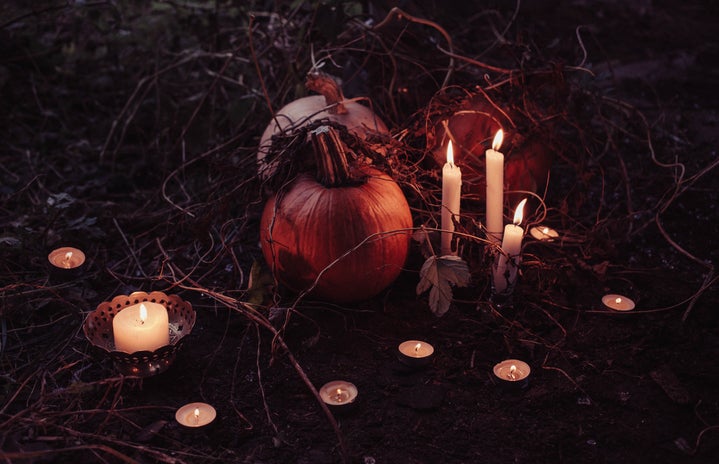When I think about chilling stories and poems, Edgar Allan Poe is the first author that comes to my mind, and for good reason. An icon introduced to many in middle or high school English classes, his pieces have a depth and complexity that can and should be enjoyed outside of an academic context. Though not all of his stories and poems have a mysterious or eerie feel, many of them do, and they’re perfect to read to get in the mood for the spooky season. Here are some of my favorites.
- The Tell-Tale Heart
-
Probably one of Poe’s better-known short stories, “The Tell-Tale Heart” follows a potentially unreliable narrator who is driven into paranoia over an old man’s eye. Though it’s not filled with traditional mystery, its descriptions and narration have the same feel. Filled with confessions of other-worldly sounds and reasoning justifying the actions that this madness caused, this story reads like the defendant’s side of a story in a court scene, something that my high school English teacher took advantage of and made into a hilarious but intense project. Every time I read this story, I can’t stop wondering about the narrator’s mental stability, and whether their actions could be a due to this paranoia or if everything is an illusion altogether. “The Tell-Tale Heart” was one of the first stories that showed me how psychology, illusions and whimsy can all come together in one piece. Although the narrator is questionable, the story itself is not hard to follow, but leaves you thinking about what really happened and why.
- The Fall of the House of Usher ft. The Haunted Palace
-
More of a longer read, “The Fall of the House of Usher” gives another level of mystery and ambiguity to an already haunted house and those living inside. The story follows the narrator, whose friend is physically and mentally unwell and has asked him to come and visit. As with all haunted houses, we’re given a description of its gloom, and we follow the narrator and his friend through the friend’s anxiousness, mania and hallucinations. Family lines, the dead and undead and eerie sub-stories all come together to make an unsettling piece. The poem “The Haunted Palace” also makes an appearance in the story as a song that compares the Usher house to a beautiful palace that has since deteriorated due to fear and sorrow. While the story itself is longer and can be a bit hard to follow at times because its particular diction isn’t common in short stories today, its mysterious elements and building plot make for a thoughtful and spooky read.
- For Annie
-
I chose to add “For Annie” to the list to brighten up the selection, even if it’s in a dim way. Instead of referring to death as something to dread, the narrator of this poem is calmly awaiting it as he lays in bed. Though he knows that Annie — his lover — is upset, he is at peace, knowing that he’ll be even more alive once he is gone because of Annie’s love. This poem is more chilling than mysterious, as it contrasts the narrator’s outlook on death versus Annie’s and most people’s thoughts towards it. Its straightforwardness in laying death (no pun intended) in a different light gives it a contemplative spookiness that leaves death and any feelings towards it up for interpretation.
- Annabel Lee
-
If the feeling in “For Annie” were to stem from the Grimm Fairy Tales, the soft tone of “Annabel Lee” would be likened to its Disney adaptation. “Annabel Lee” is a poem about the death of a lover, this time from the perspective of a man who watched his love pass away. Filled with memories and fantasy-like elements, the poem tells of their love and follows the narrator’s thoughts as he concludes that Annabel Lee was taken away because of the two’s passionate love for each other. Like “For Annie,” this poem is more chilling than mysterious, but this one is chilling in a softer way — like when you’re outside on fall afternoon and feel a chill as a gust of wind blows, even if you’re wearing a sweater — and it’s this kind of melancholic surrealness that makes it so good. More of a love story that would inspire princess costumes than a spooky one that would inspire ghost ones, “Annabel Lee” still succeeds in chilling one’s core, but in a subtler way.
- The Raven
-
I couldn’t have ended this list without adding “The Raven.” One of Poe’s most iconic pieces, this poem tells about a raven’s visit to a man who is mourning his lover (a theme, we can see, that is reoccurring in his work). The bird surprises the narrator by saying “nevermore” in response to the man’s initial thoughts, but this word quickly turns to haunt him as the narrator shifts to ask the bird questions about his dead lover. Besides having an intense rhyme and feel, what stands out the most about this poem is its unnerving effect on both the narrator and the reader. Unlike the two poems above, this narrator is clearly not at rest about what happened to his love. The repetition and interchange between the words “nothing more” and “nevermore” add to the despair that is looming over the narrator, and the allusions to Pallas Athena open it up to more interpretation as well. Though this is a slightly longer piece, its story is relatively easy to follow and one that can also leave you thinking.
With midterm season passed and exam season coming up, reading outside of school has been a rarity for me. Rereading these poems and short stories, though, reminded me of why I loved them so much, and they have helped me get excited again for fall and spooky season.


